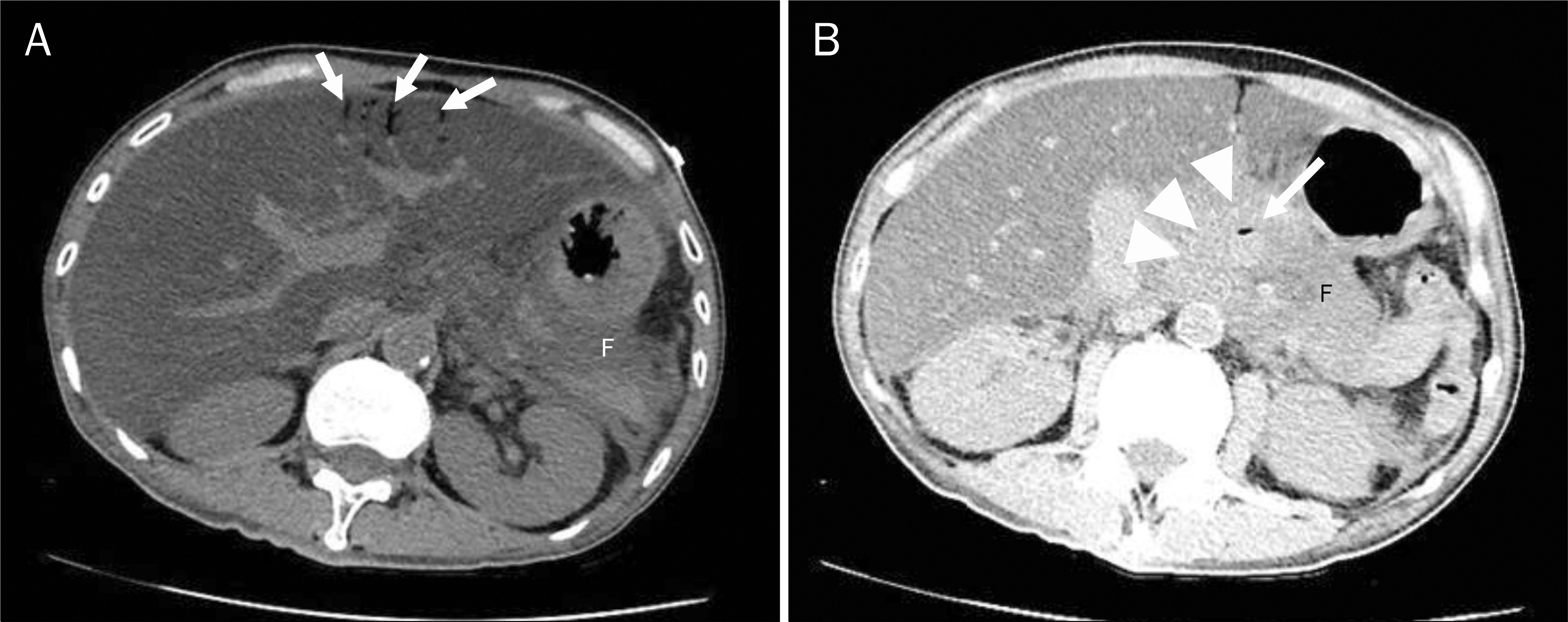Korean J Gastroenterol.
2013 Mar;61(3):170-173. 10.4166/kjg.2013.61.3.170.
A Case of Successful Treatment of Portal Venous Gas Caused by Acute Pancreatitis
- Affiliations
-
- 1Department of Internal Medicine, Myongji Hospital, Kwandong University College of Medicine, Goyang, Korea. Chg21@kwandong.ac.kr
- 2Department of Radiology, Myongji Hospital, Kwandong University College of Medicine, Goyang, Korea.
- 3Department of Surgery, Myongji Hospital, Kwandong University College of Medicine, Goyang, Korea.
- KMID: 1501641
- DOI: http://doi.org/10.4166/kjg.2013.61.3.170
Abstract
- Hepatic portal venous gas (HPVG) has been considered a rare entity associated with a poor prognosis. Portal vein gas is most commonly caused by mesenteric ischemia but may have a variety other causes. HPVG can be associated with ischemic bowel disease, inflammatory bowel disease, intra-abdominal abscess, small bowel obstruction, acute pancreatitis, and gastric ulcer. Because of high mortality rate, most HPVG requires emergent surgical interventions and intensive medical management. We experienced a case of hepatic portal venous gas caused by acute pancreatitis and successfully treated with medical management.
MeSH Terms
Figure
Reference
-
References
1. Park HC, Lee WS, Joo SY, et al. Hepatic portal venous gas associated with acute pancreatitis: reports of two cases and review of literature. Korean J Gastroenterol. 2007; 50:131–135.2. Wolfe JN, Evans WA. Gas in the portal veins of the liver in infants; a roentgenographic demonstration with postmortem anatomical correlation. Am J Roentgenol Radium Ther Nucl Med. 1955; 74:486–488.3. Sebastià C, Quiroga S, Espin E, Boyé R, Alvarez-Castells A, Armengol M. Portomesenteric vein gas: pathologic mechanisms, CT findings, and prognosis. Radiographics. 2000; 20:1213–1224.
Article4. Iannitti DA, Gregg SC, Mayo-Smith WW, et al. Portal venous gas detected by computed tomography: is surgery imperative? Dig Surg. 2003; 20:306–315.
Article5. Liebman PR, Patten MT, Manny J, Benfield JR, Hechtman HB. Hepatic-portal venous gas in adults: etiology, pathophysiology and clinical significance. Ann Surg. 1978; 187:281–287.6. Faberman RS, Mayo-Smith WW. Outcome of 17 patients with portal venous gas detected by CT. AJR Am J Roentgenol. 1997; 169:1535–1538.
Article7. Kinoshita H, Shinozaki M, Tanimura H, et al. Clinical features and management of hepatic portal venous gas: four case reports and cumulative review of the literature. Arch Surg. 2001; 136:1410–1414.8. Wiot JF, Felson B. Gas in the portal venous system. Am J Roentgenol Radium Ther Nucl Med. 1961; 86:920–929.9. Ha NR, Lee HL, Lee OY, et al. A case of Crohn's disease presenting with free perforation and portal venous gas. Korean J Gastroenterol. 2007; 50:319–323.
- Full Text Links
- Actions
-
Cited
- CITED
-
- Close
- Share
- Similar articles
-
- Hepatic Portal Venous Gas Associated with Acute Pancreatitis: Reports of Two Cases and Review of Literature
- Portal Venous Gas after Insertion Umbilical Venous Catheter: A Case Report
- A Case of Hepatic Portal Venous Gas Caused by Clostridium perfringens in a Patient with Mesenteric Atriovenous Malformation and Portal Hypertension
- A Case of Crohn's Disease Presenting with Free Perforation and Portal Venous Gas
- A Case of Portal Vein Thrombosis Associated with Acute Pancreatitis and Cholangitis



